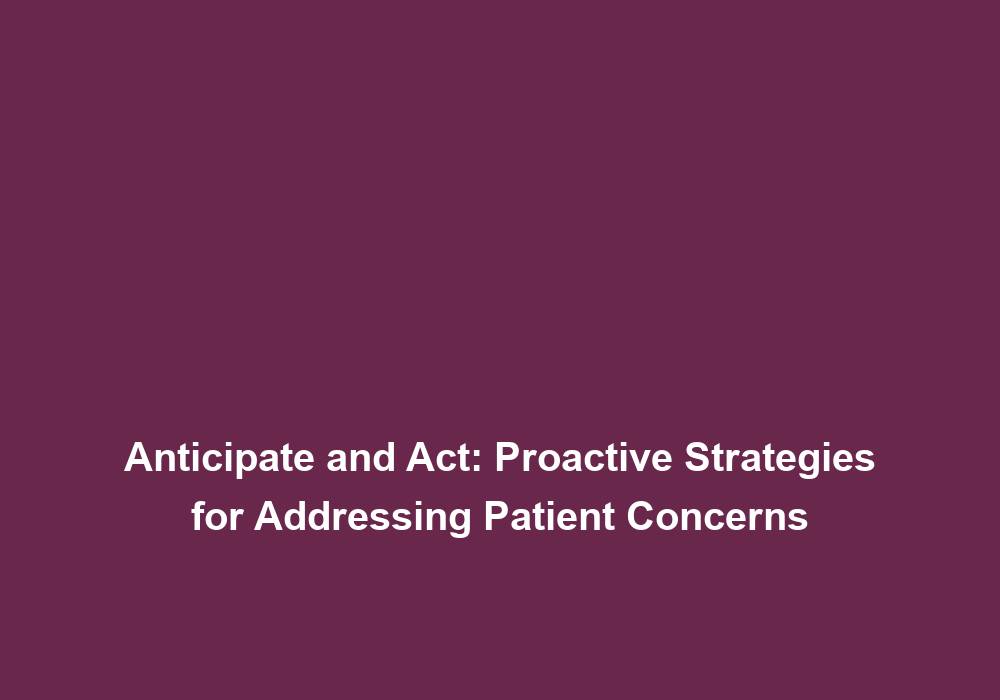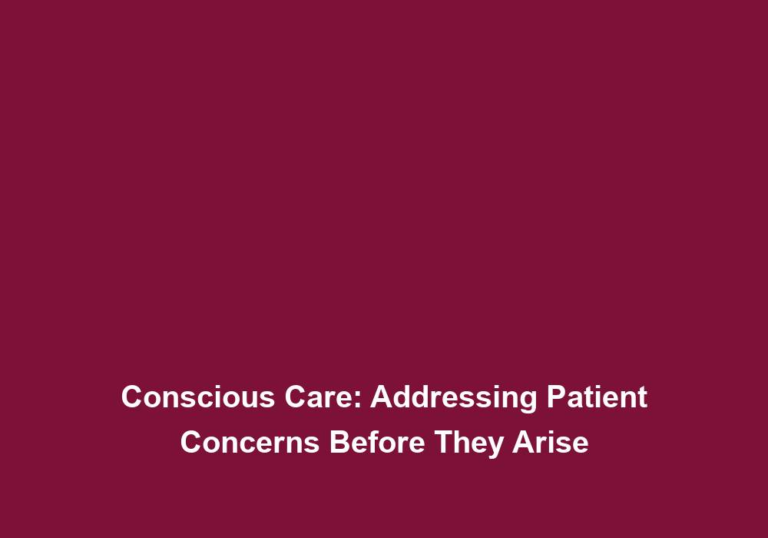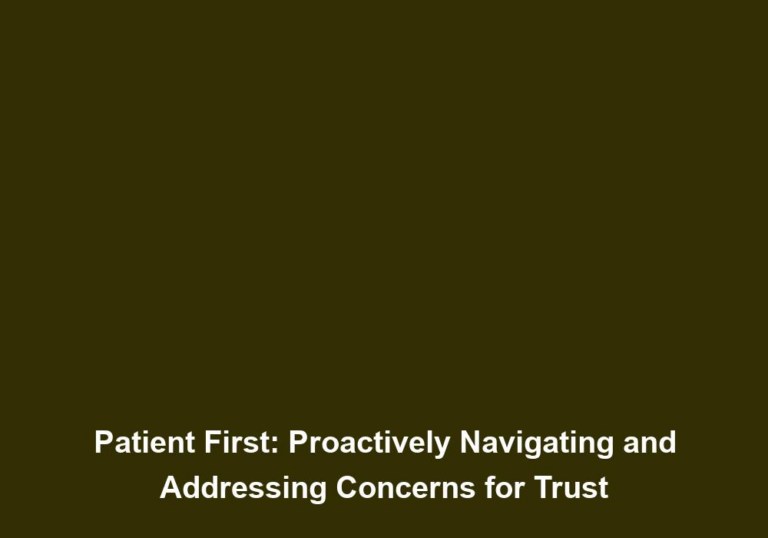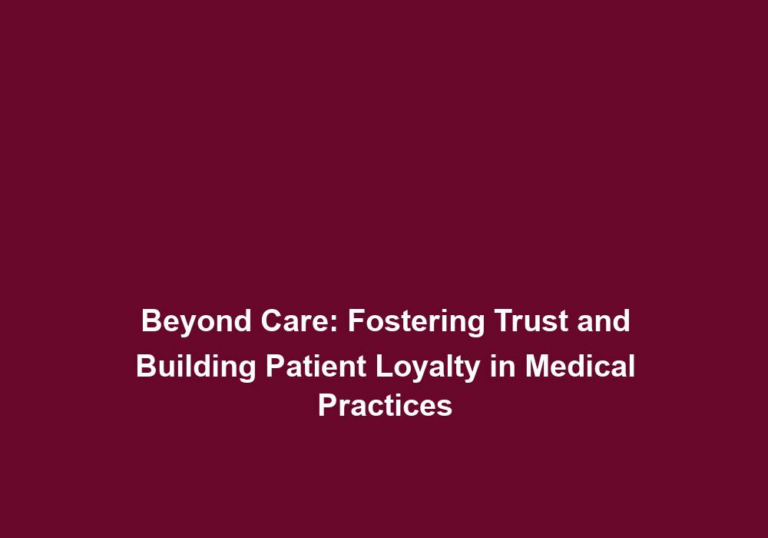Anticipate and Act: Proactive Strategies for Addressing Patient Concerns
In the fast-paced healthcare industry, it is crucial for healthcare providers to adopt proactive strategies for addressing patient concerns. By anticipating potential issues and taking proactive steps to address them, healthcare providers can enhance patient satisfaction, improve patient outcomes, and foster a trusting relationship between patients and providers. In this article, we will discuss effective strategies and best practices for anticipating and acting on patient concerns.
Why Addressing Patient Concerns Proactively Matters
Addressing patient concerns proactively demonstrates a commitment to patient-centered care and ensures that patients feel heard and valued. By taking the initiative to address concerns before they escalate, healthcare providers can prevent potential complications, enhance the patient experience, and build trust with patients. Proactive strategies also contribute to improved patient outcomes and reduce the risk of medical malpractice claims.
Proactively addressing patient concerns is crucial for several reasons:
-
Preventing Complications: By addressing concerns before they escalate, healthcare providers can prevent potential complications. For example, if a patient expresses confusion about their medication instructions, proactively clarifying and providing additional information can prevent medication errors and adverse reactions.
-
Enhancing Patient Experience: Patients want to feel heard and valued by their healthcare providers. By proactively addressing their concerns, providers show that they prioritize their patients’ well-being and are committed to providing high-quality care. This enhances the overall patient experience and fosters a positive relationship between patients and providers.
-
Building Trust: Trust is a foundational element of the patient-provider relationship. When healthcare providers anticipate and address patient concerns proactively, it builds trust. Patients feel confident that their concerns will be heard and addressed, leading to a stronger bond between patients and providers.
-
Improving Patient Outcomes: Proactive strategies help improve patient outcomes by ensuring that potential issues are identified and addressed in a timely manner. For example, if a patient expresses concerns about their treatment plan, proactive steps can be taken to reassess and modify the plan to better meet the patient’s needs, leading to improved health outcomes.
-
Reducing Medical Malpractice Claims: Addressing patient concerns proactively can also help reduce the risk of medical malpractice claims. When patients feel that their concerns are taken seriously and addressed promptly, they are less likely to seek legal recourse.
Anticipating Patient Concerns
To effectively address patient concerns, healthcare providers must first anticipate what these concerns may be. Here are some common patient concerns that providers should be prepared for:
1. Communication Issues
Patients often have concerns related to poor communication, such as difficulty understanding medical jargon, feeling rushed during appointments, or not receiving timely updates about their condition or treatment plan. Healthcare providers should be proactive in ensuring clear and effective communication with patients.
Some strategies to address communication issues include:
- Using plain language: Healthcare providers should avoid using complex medical terminology and explain information in a way that patients can easily understand.
- Allowing enough time for appointments: Providers should allocate sufficient time for patient visits to ensure that patients do not feel rushed and have ample opportunity to discuss their concerns.
- Providing timely updates: Keeping patients informed about their condition, test results, and treatment plan on a regular basis helps alleviate anxiety and ensures that patients are actively engaged in their healthcare journey.
2. Care Coordination
Patients may have concerns about the coordination of their care, especially if they are seeing multiple healthcare providers or transitioning between different healthcare settings. Proactive strategies should focus on streamlining care coordination and improving the patient experience during transitions of care.
Strategies to improve care coordination include:
- Interoperability between healthcare systems: Healthcare providers should prioritize the seamless sharing of patient information between different systems to ensure that all relevant healthcare professionals have access to complete and up-to-date information.
- Utilizing electronic health records (EHRs): EHRs can facilitate information sharing and provide a comprehensive view of a patient’s medical history, medications, and treatment plans, enabling better coordination among healthcare providers.
- Establishing effective communication channels: Healthcare teams should have clear channels of communication to ensure that important information is shared promptly and accurately. This can include regular meetings, secure messaging platforms, or shared electronic calendars.
3. Financial Concerns
Financial concerns are a major source of anxiety for many patients. Providers should anticipate questions about insurance coverage, billing practices, and the cost of treatments. Offering transparent and upfront information about financial matters can help alleviate patient concerns.
Strategies for addressing financial concerns include:
- Offering financial counseling services: Healthcare providers can have dedicated staff members who assist patients in understanding their insurance coverage, navigating financial assistance programs, and providing estimates of out-of-pocket costs.
- Providing cost estimates: When discussing treatment options with patients, providers should provide clear and detailed cost estimates to help patients make informed decisions.
- Explaining billing practices: Healthcare providers should communicate clearly about their billing practices, including accepted insurance plans, payment options, and any financial assistance programs available. This transparency helps patients understand their financial obligations and reduces uncertainty.
4. Timely Access to Care
Long wait times for appointments or delays in receiving test results can lead to patient frustration and anxiety. Providers should implement strategies to ensure timely access to care, such as optimizing appointment scheduling systems and promptly communicating test results.
Strategies to streamline access to care include:
- Optimizing appointment scheduling: Providers should assess appointment scheduling processes to identify bottlenecks and implement improvements. This can include offering flexible scheduling options, utilizing technology to automate scheduling, and minimizing wait times.
- Offering telehealth options: Telehealth services can provide patients with convenient access to healthcare professionals, reducing the need for in-person visits and potentially decreasing wait times.
- Implementing triage systems: Healthcare providers can establish triage systems to prioritize urgent cases, ensuring that patients with critical needs receive timely care. This can involve training staff to identify urgent cases and expedite their appointments or referrals.
5. Quality of Care
Patients may have concerns about the quality of care they receive. Providers should proactively address these concerns by ensuring adherence to evidence-based practices, ongoing staff training, and soliciting patient feedback to continuously improve the quality of care provided.
Strategies to address concerns about the quality of care include:
- Adhering to evidence-based practices: Healthcare providers should stay updated on the latest research and guidelines in their respective fields to ensure that they are providing the most effective and appropriate care to their patients.
- Ongoing staff training: Continuous education and training for healthcare professionals help ensure that they are equipped with the necessary skills and knowledge to deliver high-quality care.
- Soliciting patient feedback: Regularly seeking feedback from patients through surveys, focus groups, or patient satisfaction questionnaires can provide valuable insights into areas for improvement. Acting on this feedback demonstrates a commitment to addressing patient concerns and continuously enhancing the quality of care.
Proactive Strategies for Addressing Patient Concerns
Once potential patient concerns are anticipated, healthcare providers can implement proactive strategies to address them effectively. Here are some best practices to consider:
1. Enhance Communication
Effective communication is at the core of addressing patient concerns. Providers should strive for clear, concise, and empathetic communication. This includes using plain language, actively listening to patients, and offering opportunities for patients to ask questions and provide feedback. Regularly assessing patient understanding of their condition and treatment plan can help identify and address communication gaps.
Some additional strategies to enhance communication include:
- Providing written materials: Healthcare providers can provide written materials, such as brochures or handouts, to help patients understand their condition, treatment options, and self-care instructions. This allows patients to refer back to information at their own pace and reinforces key points.
- Utilizing visual aids: Visual aids, such as diagrams, charts, or videos, can help simplify complex medical concepts and improve patient understanding.
- Utilizing interpreter services: For patients with limited English proficiency or those who are deaf or hard of hearing, healthcare providers should offer interpreter services to ensure effective communication.
2. Improve Care Coordination
To enhance care coordination, providers should prioritize interoperability between different healthcare systems, utilize electronic health records to facilitate information sharing, and establish effective communication channels among healthcare team members. Proactive care coordination strategies can prevent potential breakdowns in patient care and ensure a seamless healthcare experience.
In addition to the previously mentioned strategies, providers can consider:
- Designating care coordinators: Assigning care coordinators to patients can help ensure that all aspects of their care are well-coordinated and that information is effectively communicated between healthcare providers.
- Conducting regular care coordination meetings: Regular meetings among healthcare team members, including primary care physicians, specialists, nurses, and social workers, can facilitate collaborative care planning and address any coordination challenges.
- Implementing standardized care protocols: Establishing standardized protocols for common procedures or conditions can help streamline care coordination and ensure that all healthcare providers follow consistent practices.
3. Offer Financial Counseling
To alleviate patients’ financial concerns, providers should offer financial counseling services. These services can help patients understand their insurance coverage, assist in navigating financial assistance programs, and provide estimates of out-of-pocket costs. By proactively addressing financial concerns, providers can reduce patient stress and improve patient satisfaction.
Additional strategies for offering financial counseling include:
- Providing resources for financial assistance: Healthcare providers can maintain a list of resources, such as government programs or charitable organizations, that offer financial assistance to patients in need. They can share this information with patients who may benefit from these resources.
- Exploring payment options: Providers can offer flexible payment options, such as payment plans or discounted rates for uninsured or underinsured patients. This can help alleviate financial burdens and ensure that patients can afford necessary care.
4. Streamline Access to Care
Providers should implement strategies to reduce wait times and improve access to care. This can include optimizing appointment scheduling processes, offering telehealth options, implementing triage systems to prioritize urgent cases, and providing patients with clear instructions on how to seek timely care during emergencies or after-hours.
Additional strategies to streamline access to care include:
- Utilizing online appointment scheduling: Implementing an online appointment scheduling system allows patients to easily schedule appointments at their convenience, reducing the need for phone calls and potentially decreasing wait times.
- Implementing reminder systems: Sending automated reminders for appointments and test results can help patients stay informed and ensure that they do not miss important healthcare interactions.
- Providing after-hours care options: Healthcare providers can establish partnerships with urgent care centers or hospitals to ensure that patients have access to care outside regular office hours.
5. Emphasize Patient-Centered Care
A patient-centered approach is paramount in addressing patient concerns effectively. Providers should actively involve patients in their care decisions, respect their autonomy, and foster a collaborative relationship. Regularly seeking patient feedback through surveys or focus groups can provide valuable insights for improvement and help address concerns proactively.
Strategies to emphasize patient-centered care include:
- Shared decision-making: Healthcare providers should engage patients in shared decision-making, presenting them with all available treatment options, risks, benefits, and alternatives. This allows patients to actively participate in their care and make informed decisions.
- Respecting cultural and personal preferences: Recognizing and respecting the cultural, religious, and personal preferences of patients contribute to a patient-centered approach. Providers should be sensitive to individual needs and tailor care accordingly.
- Creating a welcoming and inclusive environment: Healthcare providers should strive to create an environment that is welcoming, inclusive, and free from discrimination. This includes training staff on cultural competence and implementing policies that promote diversity and inclusion.
Conclusion
Anticipating and acting on patient concerns is crucial for healthcare providers to deliver high-quality, patient-centered care. By adopting proactive strategies and implementing best practices, providers can enhance patient satisfaction, improve patient outcomes, and establish a culture of trust and open communication. Embracing a proactive approach to addressing patient concerns not only benefits individual patients but also contributes to the overall improvement of healthcare delivery.







